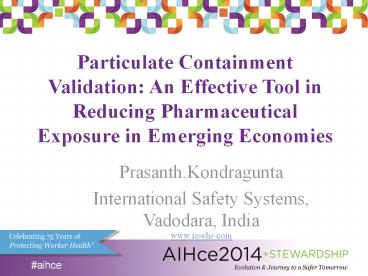Particulate Containment Validation By Prashant Kondragunta, ISS
Title:
Particulate Containment Validation By Prashant Kondragunta, ISS
Description:
Particulate Containment Validation: An Effective Tool in Reducing Pharmaceutical Exposure in Emerging Economies –
Number of Views:130
Updated: 30 September 2014
Slides: 17
Provided by:
issehs
Category:
How To, Education & Training
Tags:
Title: Particulate Containment Validation By Prashant Kondragunta, ISS
1
Particulate Containment Validation An Effective
Tool in Reducing Pharmaceutical Exposure in
Emerging Economies
- Prasanth.Kondragunta
- International Safety Systems, Vadodara, India
- www.issehs.com
aihce
2
Agenda
- Introduction
- Contract Manufacturing (CM) sites scenario in
India - Challenges at CM sites
- Particulate Containment Validation
- Validation Procedure
- Results
- Conclusion
3
Introduction Pharmaceutical Industries
- Pharmaceutical manufacturing is growing at 14 to
17 per year in emerging economies, specifically
China and India - Outsourcing of work to Contract Manufacturers
(CM) expected to exceed 53 Billion - Active Pharmaceutical Ingredient (API)
manufacturing - Bulk drug is manufactured
- Large volume handled potential solid exposure
risk is high - Formulation or Dosage Form
- Solids and liquid pharmaceuticals are made
- Potential solid API exposure risk is high
4
Contract Manufacturing Scenario in India
- Third party/Contract Manufacturing (CM) sites are
increasing rapidly - low labour costs,
- large existing pharmaceutical manufacturing base,
- sizable patient population
- large number of qualified pharmacists and
chemists
5
Challenges at CM sites
- Safety professionals or occupational physicians
practicing IH - Limited sensitivity of site professionals to
degree of hazard of Active Pharmaceutical
Ingredients (APIs). - No risk assessment and evaluation through
industrial (or occupational) hygiene assessment
to determine potential exposure of APIs to
workers. - Occupational Exposure Limits (OELs) are not
available for large number of APIs and
intermediates. - Validated analytical methods are not available
for large number of APIs - No accredited laboratories are available in India
for API analysis
6
Challenges at CM sites
- Categorizing (or banding) the API based on
inherent potency and toxicity, linking the
category to safe handling practices and control
strategies - Open handling of potent compounds
- High reliability on Personal Protective Equipment
(PPE) - No Segregated gowning and de-gowning areas
provided with a room airlock or anteroom. - Limited knowledge and application of appropriate
containment and control measures to maintain
exposures below acceptable levels.
7
Particulate Containment Validation
- Surrogate monitoring Lactose/Naproxen Sodium
- International Society for Pharmaceutical
Engineering (ISPE) - Standardized Measurement of Equipment Particulate
Airborne Concentration (SMEPAC) Committee - ISPE Good Practice Guide Assessing the
Particulate Containment Performance of
Pharmaceutical Equipment - Standardized method of measuring
- Performance of containment systems against
specific challenge - Establish an agreed and valid method that can be
used to meet the requirements of practitioners
and supplier organizations
8
Example of Laminar Flow Booth Surrogate
Monitoring
9
Validation Procedure
- Certified Industrial Hygienist (CIH) reviewed the
containment systems installed in an ABC company
and provided a draft particulate containment
validation plan. - Surrogate monitoring was carried out for four
numbers of stainless steel negative pressure
rigid isolators - Dispensing
- Compounding
- Unloading from Vacuum Tray Drier
- Sifting, Milling and Pack Off
- Containment Performance Target (CPT) was 1 µg/m3
10
Methods
- Lactose was chosen as surrogate Limit Of
Quantitation (LOQ) of 2.5 nanograms - Personal, area/static samples and wipe samples
were collected as per ISPE protocol. - Three Iterations were considered for performance
verification. - 25mm, 1 micron Teflon filters sampling flow
rates were approximately 2 L/Min. - 100 cm2 surfaces of the equipment and surrounding
areas using swabs and distilled water as a
wetting agent. - AIHA accredited laboratory analyzed the samples
11
Results
- Dispensing Isolator
- Personal Breathing Zone - 0.07 µg/m3 to 0.33
µg/m3 - Area Static - 0.01 µg/m3 to 0.17 µg/m3
- Wipe/Swab 0.127 µg/100 cm2 to 7.54 µg/100 cm2
- Compounding Isolator
- Personal Breathing Zone - 0.03 µg/m3 to 0.23
µg/m3 - Area Static - 0.01 µg/m3 to 0.72 µg/m3
- Wipe/Swab 6 µg/100 cm2 to 23.3 µg/100 cm2
12
Results
- Vacuum Tray Drier Isolator
- Personal Breathing Zone - 0.03 µg/m3 to 0.24
µg/m3 - Area Static - 0.01 µg/m3 to 0.06 µg/m3
- Wipe/Swab 1.11 µg/100 cm2 to 3.44 µg/100 cm2
- Sifting, Milling and Pack off Isolator
- Personal Breathing Zone - 0.09 µg/m3 to 0.34
µg/m3 - Area Static - 0.01 µg/m3 to 0.8 µg/m3
- Wipe/Swab 0.05 µg/100 cm2 to 4.3 µg/100 cm2
13
Recommendations
- Although air sample results were below CPT of 1
µg/m3, surface contamination results exceeded 10
times the CPT of 10 µg/cm2 and hence following
recommendations were provided - Rectify the containment breach near glove port
- Cleaning of spills immediately with wet wipes
- Wet wiping of the poly bag outer surface before
taking out the bag into Rapid Transfer Port (RTP)
canister - Ensure use of High Efficiency Particulate Air
(HEPA) filter equipped vacuum cleaner for the
cleaning and housekeeping activities. - Ensure operators take shower to decontaminate the
full body suit after use and before removing the
suit to avoid potential exposure to API while
removing contaminated suit.
14
Conclusion
- Particulate Containment Validation process was
effective in identifying exposure and
contributing factors. - The results of the particulate containment review
of the isolators indicated that all the four
isolators can be operated with API containment
level below 1 µg/m3 . - The Contract Manufacturing site leadership team
recognized the importance of particulate
containment validation review to determine the
overall potential occupational health risk.
15
References
- www.gpcmevent.com
- www.pharmaceutical-technology.com
- www.pharmoutsourcing.com
16
Questions?
- Prasanth.K (prasanth.k_at_issehs.com)
aihce































